 Needs Pictures: 0
Needs Pictures: 0
Results 1 to 15 of 15
Thread: Router Table Adventure
-
5th February 2021, 03:03 AM #1
 Router Table Adventure
Router Table Adventure
I have just completed another router table: http://www.inthewoodshop.com/Powered...Adventure.html

This is built into the outfeed of my table saw. It features a number of interesting items: fully-functioning fence, JessEm guides, Router Raizer, Wixey digital gauge, and amazing dust collection!
The aim was to build a router table with good features, and at a reasonable cost. To do this, there is no expensive router lift, and the fence is shop-made.
I hope it offers up some ideas for others.
Regards from Perth
DerekVisit www.inthewoodshop.com for tutorials on constructing handtools, handtool reviews, and my trials and tribulations with furniture builds.
-
5th February 2021 03:03 AM # ADSGoogle Adsense Advertisement
- Join Date
- Always
- Location
- Advertising world
- Posts
- Many
-
5th February 2021, 08:16 AM #2
 GOLD MEMBER
GOLD MEMBER











- Join Date
- Jul 2011
- Location
- In between houses
- Posts
- 1,784

Are those holddowns rolling? Spring loaded for down pressure?
-
5th February 2021, 11:42 AM #3

WOW. You are brave, Derek. I had a look on the Jessem website and the first thing I noticed was the health warning:

WARNING - Cancer and Reproductive harm. For more information please click: JessEm Prop65 Warnings or www.P65Warnings.ca.gov
-
5th February 2021, 02:39 PM #4

Graeme!!

These warnings apply to everything ... in California ...
 WARNING: This product(s) can expose you to chemicals including Lead and/or Chromium, known to the State of California to cause cancer and birth defects or other reproductive harm.
WARNING: This product(s) can expose you to chemicals including Lead and/or Chromium, known to the State of California to cause cancer and birth defects or other reproductive harm.
For more information please visit: www.P65Warnings.ca.gov
WOOD DUST - All of JessEm's Products either create or assist in the creation of wood dust. (See our list below for products that fall under this category)
 WARNING: Drilling, sawing, sanding or machining wood products can expose you to wood dust, a substance known to the State of California to cause cancer. Avoid inhaling wood dust or use a dust mask or other safeguards for personal protection. For more information please visit: www.P65Warnings.ca.gov
WARNING: Drilling, sawing, sanding or machining wood products can expose you to wood dust, a substance known to the State of California to cause cancer. Avoid inhaling wood dust or use a dust mask or other safeguards for personal protection. For more information please visit: www.P65Warnings.ca.gov
Regards from Perth
Derek
Visit www.inthewoodshop.com for tutorials on constructing handtools, handtool reviews, and my trials and tribulations with furniture builds.
-
5th February 2021, 04:19 PM #5
-
6th February 2021, 09:32 AM #6
 SENIOR MEMBER
SENIOR MEMBER











- Join Date
- Feb 2015
- Location
- Hobart
- Age
- 77
- Posts
- 648

Derek,
Are these warning signs the standard template/design for the business card of Californian litigation lawyers?
Cheers,
Yvan
-
6th February 2021, 10:33 AM #7

Yvan, imagine adding a warning to everything just in case someone sues you for not warning them beforehand? Those with commonsense need not apply.
Regards from Perth
Derek
Warning! This post may cause eye fatigue if you read it too fast, too slowly, or too many times.Visit www.inthewoodshop.com for tutorials on constructing handtools, handtool reviews, and my trials and tribulations with furniture builds.
-
6th February 2021, 12:41 PM #8
 Senior Member
Senior Member











- Join Date
- Sep 2016
- Location
- Bentleigh East
- Age
- 50
- Posts
- 423

California is probably the reason why we have instructions on shampoo bottles
Love the router table Derek
Is it different to your previous one?
-
6th February 2021, 12:59 PM #9

Thanks Spyro.
The old router table was similar ...



... however, I recognised the need to add dust collection from the underside, and there was too little space to do this. That meant I needed to rebuild the top and move the plate forward to create the necessary space. At that point I realised that I may as well design and build a better router table.
Regards from Perth
DerekVisit www.inthewoodshop.com for tutorials on constructing handtools, handtool reviews, and my trials and tribulations with furniture builds.
-
6th February 2021, 02:21 PM #10

I think that you have nailed it, Derek.
Do you intend adding a mitre fence track as per its predecessor?
Router Table.jpg
-
6th February 2021, 04:29 PM #11

Graeme, there is no need for that mitre track. In fact, I do not agree (now) with including it. I'd like to hear the views of others.
Firstly, the JessEm guides hold the workpiece against the fence, and so a feather board is not needed for narrow stock.
Secondly, I will make provision for a feather board for those instances where the JessEm guides cannot be used (such as stock which is too tall). In this case, a feather board needs one position for anchoring, and not over the width of the board. I plan to simply drill and tap the table for holding bolts. The feather board will still be able to slide back-and-forth to the bit (just not side-to-side).
Thirdly, to use a mitre track - and a mitre gauge - the fence must be parallel with the track. This is rarely the case, especially with my set up, since I move one side for fine adjustment. I may later built a slide into the fence for routing ends of boards. The mitre track is a white elephant.
Thoughts?
Regards from Perth
DerekVisit www.inthewoodshop.com for tutorials on constructing handtools, handtool reviews, and my trials and tribulations with furniture builds.
-
6th February 2021, 05:01 PM #12
-
6th February 2021, 05:17 PM #13
 Senior Member
Senior Member











- Join Date
- Sep 2016
- Location
- Bentleigh East
- Age
- 50
- Posts
- 423

I use the mitre track mainly to run a box joint jig or a spline cutting jig.
But then again I'm the guy without a table saw.
-
6th February 2021, 08:59 PM #14
 Paying homage to Pat Warner
Paying homage to Pat Warner
Hey Derek
I suspect you know how you work best and have the luxory of a fully decked out Shop with all the trimmings
I've always been a fan of Pat Warners Router Table
Micro-Adjustable Router Fence - FineWoodworking
and plan to make some of his more advanced versions like here down the track
The ultimate jig for making jigs - FineWoodworking
I dont plan to have tablesaws etc etc so my router table track saw and Nova drill press is as far as I plan to go
So need to ring everything out of my router table I can (When I build it)
Even so I always like options and sure enough if you don't include the track at some stage
your likely to wish you anchored it in (Murphys Law) Ive always found them useful adding
another dimension to innovate and problem solve when the situation (and it will) arises
Just my 2 cents worth as always looking foward to seeing your solutions unfold
Regards
NewLou Just Do The Best You Can With What You HAve At The Time
Just Do The Best You Can With What You HAve At The Time
-
7th February 2021, 12:56 AM #15

Lou, with all due respect to the late Pat Warner, he excelled at making jigs. My interest is building furniture. Pat saw the router and router table as the centre of his workshop. For myself, these are just one of many tools. If I prefer a method, it is for hand tools, and the router is simply a back up. One does not need a "fully decked out shop". I am fortunate to have one, so have a number of options available. Still, it was not always so.
I do think that a router table is a wonderful resource. However, a good router table does not need to be complex. In fact, I much prefer the KIS principle. My first router table was simply a piece of MDF with a hole for the bit. The fence was a 2x4 clamped alongside. It did good work. While this latest router table has many bells and whistles, it is still relatively simple compared to many.
This is my solution for a mitre track ...
There are two reasons to have a mitre track. The first is to attach a feather board. As I mentioned earlier, the JessEm guides do the task of holding the workpiece both down and against the fence. If the JessEm is not sufficient, I can still attach a feather board.
I was using a feather board on the table saw today to size drawer backs ...

The feather board can do double-duty at the router table. I drilled and tapped four bolt holes in line with the centre of the table ...
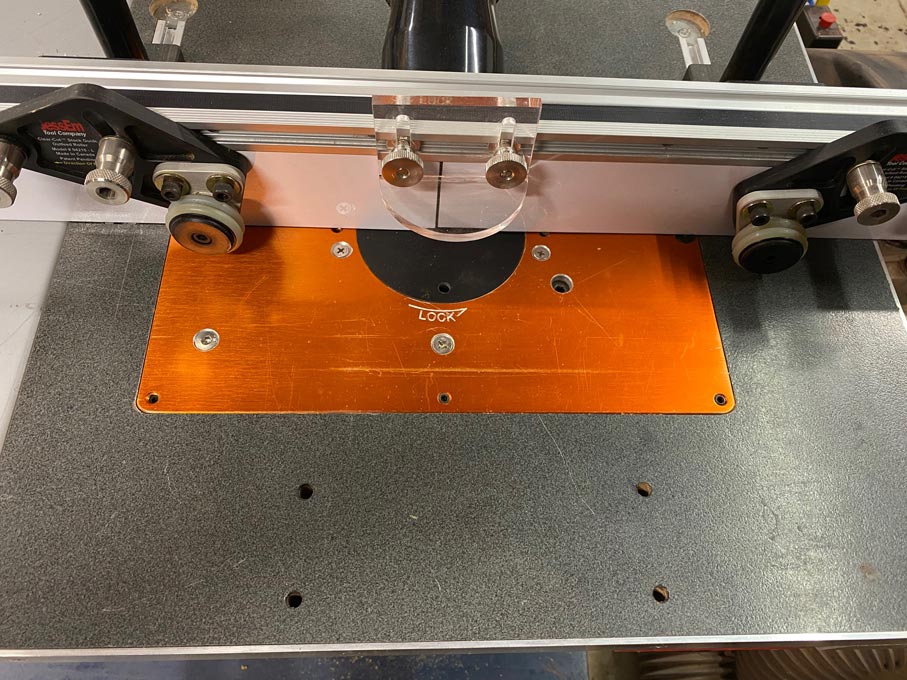
The feather board can slide back-and-forth when bolted this way. It can reach to the fence ...
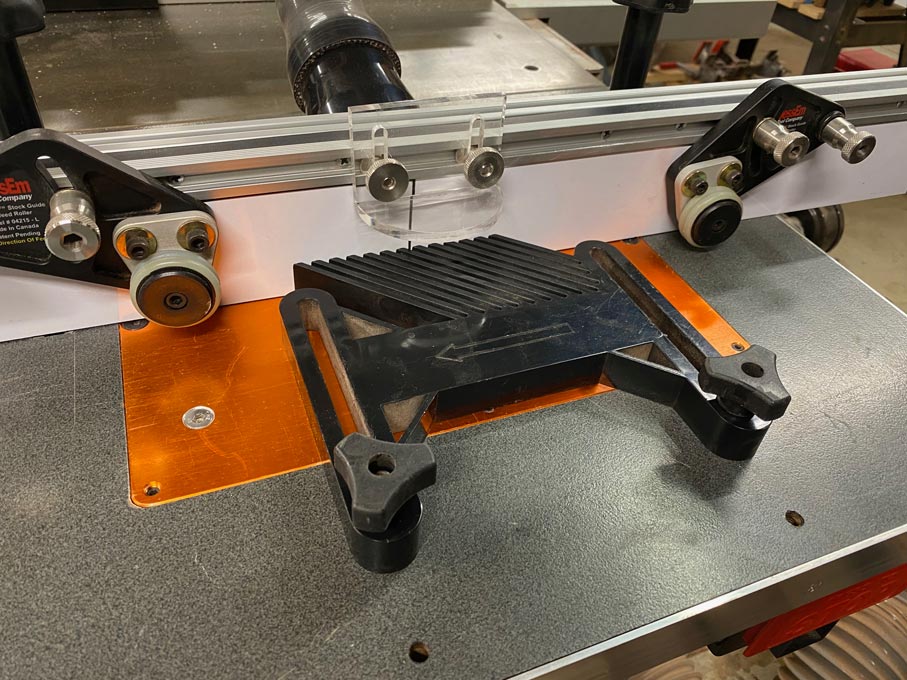
The forwards holes are where a mitre track would go. This is as far back as it would extend if in a mitre track ...
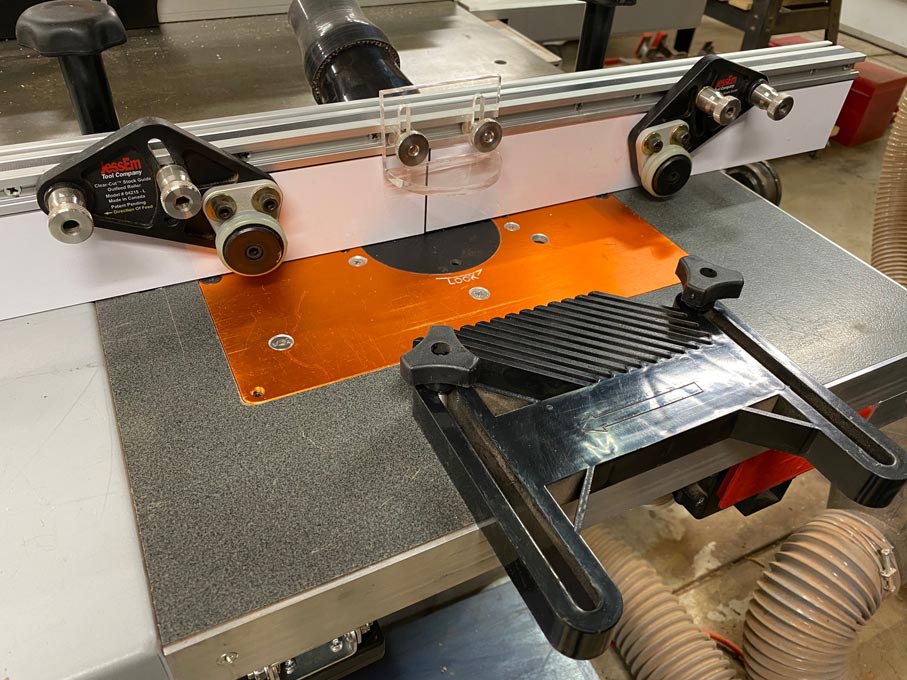
However, the second set of holes allow for a wider range ...
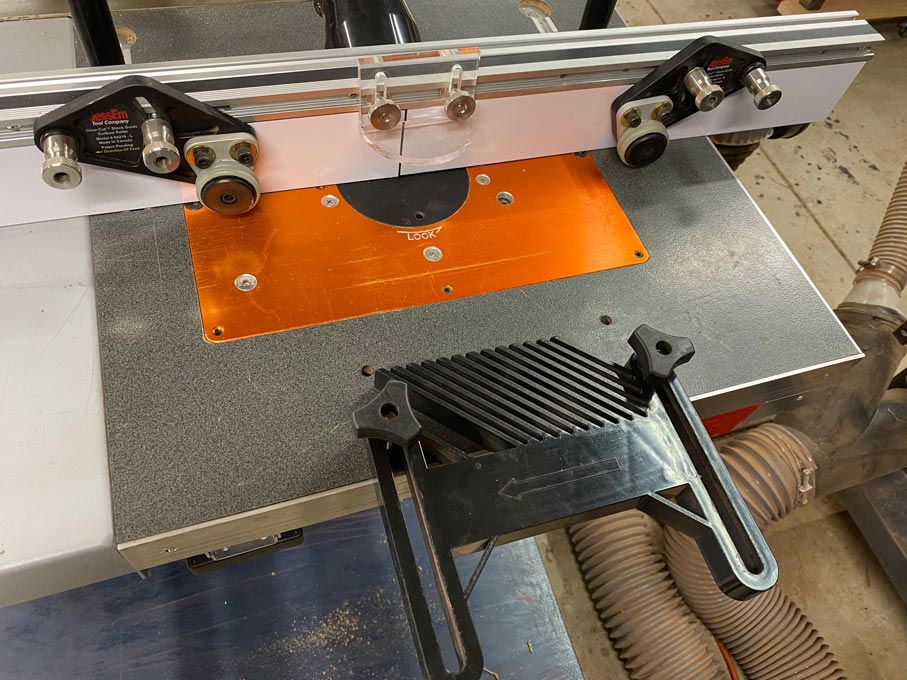
The second reason for a mitre track is to use a mitre gauge to either rout out tenon cheeks, or joints such as cope-and-stick frames or box joints. There are alternate solutions for these.
The main issue I have with the mitre gauge method is that it requires that the fence be parallel to the mitre track. Fences are rarely so in my experience. The closest I came to this was when I had a router table in a previous table saw, and it shared the table saw fence (which tracked parallel to the blade). This is not the case now. The fence rides unequally in tracks, and one side is moved to fine adjust the setting. In short, a mitre track is useless.
To make a tenon cheek, or cope the end of a stretcher for a cope-and-stick joint, simply use a backing board against the fence ...

This will not make box joints. In reality, for myself, it is unlikely that I would ever make box joints. I just cannot see a need. The closest is a dovetail joint, and I prefer doing these with hand tools. Still, were I to make a box joint, the accessory of choice would be a linear fence. These are easy-enough to build ...
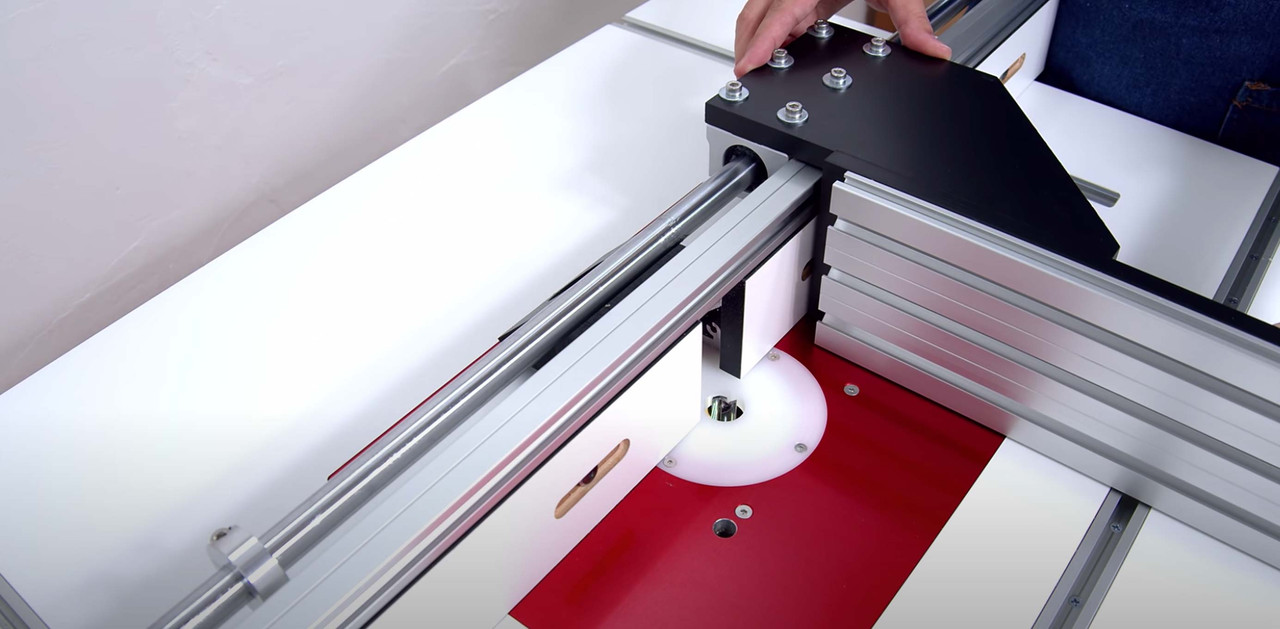
I came across a pair of excellent videos on YouTube by the same fellow. The first was on building a router table ...
The second was on building a linear fence ....
Hope this helps.
Regards from Perth
DerekVisit www.inthewoodshop.com for tutorials on constructing handtools, handtool reviews, and my trials and tribulations with furniture builds.
Similar Threads
-
SOLD: Router Lift, Lge C/Iron Table, H/D Stand on Wheels, Triton Router + Loads Router Bits
By aarggh in forum WOODWORK - Tools & MachineryReplies: 16Last Post: 7th November 2020, 02:27 PM -
Plunge router for router table with above-table adjustments?
By Old Hilly in forum ROUTING FORUMReplies: 27Last Post: 6th February 2019, 08:31 AM -
Triton Router table RTA300 VS Carba-Tec Cast Iron Top Router Table
By pellcorp in forum TRITON / GMCReplies: 17Last Post: 30th April 2009, 02:43 PM -
What is a good router table/router table accessories?
By SilverSniper in forum ROUTING FORUMReplies: 22Last Post: 4th March 2009, 10:05 AM



 Thanks:
Thanks:  Likes:
Likes:  Picture(s) thanks:
Picture(s) thanks: 
 Reply With Quote
Reply With Quote
